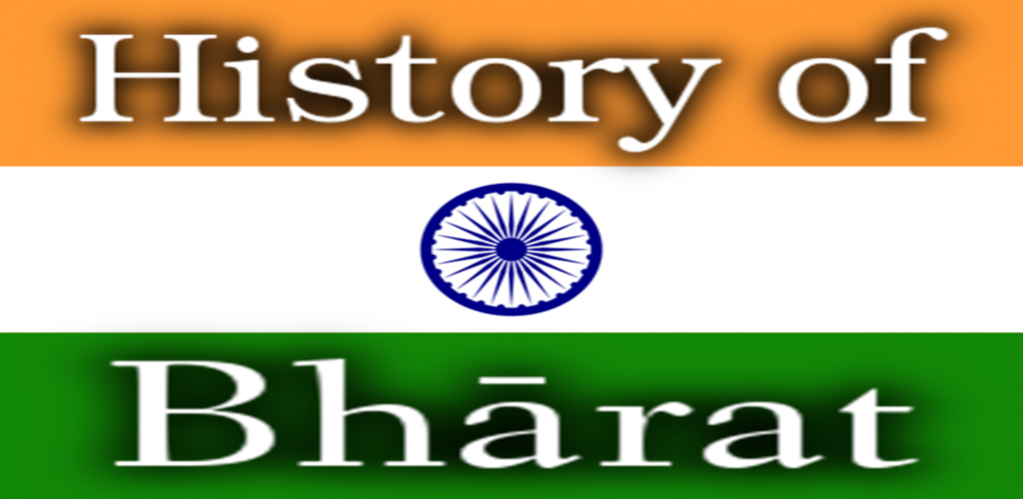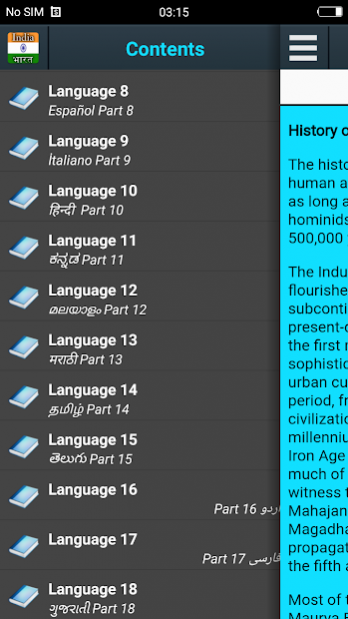History of India 2.9
Free Version
Publisher Description
Anatomically modern humans are thought to have arrived on the Indian subcontinent between 73,000 and 55,000 years ago. Settled life, which involves the transition from foraging to farming and pastoralism, began in South Asia around 7,000 BCE; during this period, domestication of wheat and barley, rapidly followed by that of goats, sheep, and cattle occurred. By 4,500 BCE, settled life had become more widely prevalent, and eventually evolved into the Indus Valley Civilization. Considered a cradle of civilisation, the Indus Valley civilisation, which spread and flourished in the north-western part of the Indian subcontinent from 3300 to 1300 BCE, was the first major civilisation in South Asia.A sophisticated and technologically advanced urban culture developed in the Mature Harappan period, from 2600 to 1900 BCE. Indus Valley Civilisation was noted for developing new techniques in handicraft, carnelian products, seal carving, metallurgy, urban planning, baked brick houses, efficient drainage systems, water supply systems and clusters of large non-residential buildings.This civilisation collapsed at the start of the second millennium BCE and was later followed by the Iron Age Vedic Period.
In early second millennium BCE persistent drought caused the population of the Indus Valley to scatter from large urban centres to villages. Around the same time, Indo-Aryan tribes moved into the Punjab from regions further northwest in several waves of migration. The resulting Vedic period was marked by the composition of the Vedas, large collections of hymns of these tribes whose postulated religious culture, through synthesis with the preexisting religious cultures of the subcontinent, gave rise to Hinduism. The caste system, which created a hierarchy of priests, warriors, and free peasants arose later during this period. Towards the end of the period, around 600 BCE, after the pastoral and nomadic Indo-Aryans spread from the Punjab into the Gangetic plain, large swaths of which they deforested to pave way for agriculture, a second urbanisation took place. The numerous Indo-Aryan realms, or janapadas, were consolidated into larger states, or mahajanapadas. This urbanisation was accompanied by the rise of new ascetic movements, including Jainism and Buddhism, which challenged the primacy of rituals, presided by Brahmin priests, that had come to be associated with Vedic religion, and gave rise to new religious concepts.
Most of the Indian subcontinent was conquered by the Maurya Empire during the 4th and 3rd centuries BCE. From the 3rd century BCE onwards Prakrit and Pali literature in the north and the Tamil Sangam literature in southern India started to flourish. Wootz steel originated in south India in the 3rd century BCE and was exported to foreign countries. During the Classical period, various parts of India were ruled by numerous dynasties for the next 1,500 years, among which the Gupta Empire stands out. This period, witnessing a Hindu religious and intellectual resurgence, is known as the classical or "Golden Age of India". During this period, aspects of Indian civilisation, administration, culture, and religion (Hinduism and Buddhism) spread to much of Asia, while kingdoms in southern India had maritime business links with the Middle East and the Mediterranean. Indian cultural influence spread over many parts of Southeast Asia, which led to the establishment of Indianised kingdoms in Southeast Asia (Greater India).
multi-languages app :
-English - History of India / History of Bharat
-Hindi (हिन्दी) - भारत का इतिहास
-Tamil (தமிழ்) - இந்திய வரலாறு
-Kannada (ಕನ್ನಡ) - ಭಾರತದ ಇತಿಹಾಸ
-Malayalam (മലയാളം) - ഇന്ത്യാചരിത്രം
-Urdu اردو - تاریخ ہند
-Marathi (मराठी) - भारताचा इतिहास
-Gujarati (ગુજરાતી) - ભારતનો ઇતિહાસ
-Telugu (తెలుగు) - భారతదేశ చరిత్ర
About History of India
History of India is a free app for Android published in the Reference Tools list of apps, part of Education.
The company that develops History of India is HistoryofTheWorld. The latest version released by its developer is 2.9.
To install History of India on your Android device, just click the green Continue To App button above to start the installation process. The app is listed on our website since 2021-08-22 and was downloaded 1 times. We have already checked if the download link is safe, however for your own protection we recommend that you scan the downloaded app with your antivirus. Your antivirus may detect the History of India as malware as malware if the download link to com.historyisfun.indiahistory is broken.
How to install History of India on your Android device:
- Click on the Continue To App button on our website. This will redirect you to Google Play.
- Once the History of India is shown in the Google Play listing of your Android device, you can start its download and installation. Tap on the Install button located below the search bar and to the right of the app icon.
- A pop-up window with the permissions required by History of India will be shown. Click on Accept to continue the process.
- History of India will be downloaded onto your device, displaying a progress. Once the download completes, the installation will start and you'll get a notification after the installation is finished.




